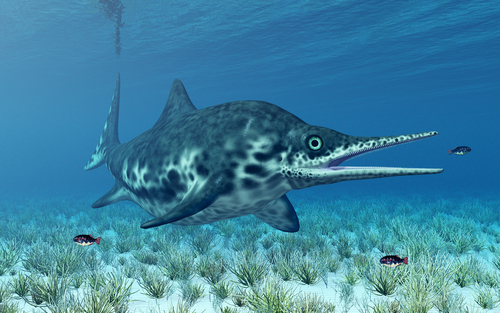GIANT ICHTHYOSAUR: 205-MILLION-YEAR-OLD JAWBONE DISCOVERED FROM ‘ONE OF LARGEST ANIMALS EVER’
A 205-million-year-old prehistoric reptile bone found on a beach in England belongs to a giant ichthyosaur, one of the largest animals that ever lived, according to an international team of researchers.
It was a jawbone of a giant ichthyosaur that, experts estimate, may have measured up to a whopping 26 meters (85 feet) long—approaching the size of some blue whales, the largest animal ever known to exist.
Ichthyosaurs are large marine reptiles that roamed the seas during the age of the dinosaurs.
The fossil was found in May 2016 on the coast of Lilstock, Somerset, in the southwest of the country, by collector Paul de la Salle, who also co-authored a new study describing the fossil which has been published in the journal PLOS One.
“Initially the bone just looked like a piece of rock, but after recognizing a groove and bone structure, I thought it might be part of a jaw from an ichthyosaur, and immediately contacted ichthyosaur experts Dean Lomax [University of Manchester] and Judy Massare [State University of New York College at Brockport], who expressed interest in studying the specimen,” de la Salle said in a statement.
Massare and Lomax analyzed the bone and found that it was incomplete and came from the lower jaw of a large ichthyosaur specimen. They also compared it to the previous largest known ichthyosaur specimen, which is kept at the Royal Tyrrell Museum of palaeontology in Alberta, Canada.
“We compared our jawbone to that of Shonisaurus sikanniensis, the largest ichthyosaur previously known, with an estimated length of up to 21 meters,” Massare told Newsweek. “Our bone was about 25 percent deeper. The estimate assumes that the two animals had a similar shape for this bone, as neither specimen preserves the entire bone.”
Because the new specimen is represented by only a large piece of jaw, it is difficult to provide a size estimate, according to Lomax. However, by using a simple scaling factor, the researchers estimated that the Lilstock specimen is about 25 percent larger.
“Other comparisons suggest the Lilstock ichthyosaur was at least 20-25 meters [67-82 feet]. Of course, such estimates are not entirely realistic because of differences between species,” Lomax said in a statement. “Nonetheless, simple scaling is commonly used to estimate size, especially when comparative material is scarce.”
In their paper, the researchers also described mysterious bone fragments found in 1850 in the nearby village of Aust, Gloucestershire, which could belong to an even larger ichthyosaur.
“We suggest in the paper that bone fragments from Aust are from the jaw of an ichthyosaur even larger than the one we described,” Massare said. “However, the Aust specimens are so fragmentary that a length estimate is not possible.”

